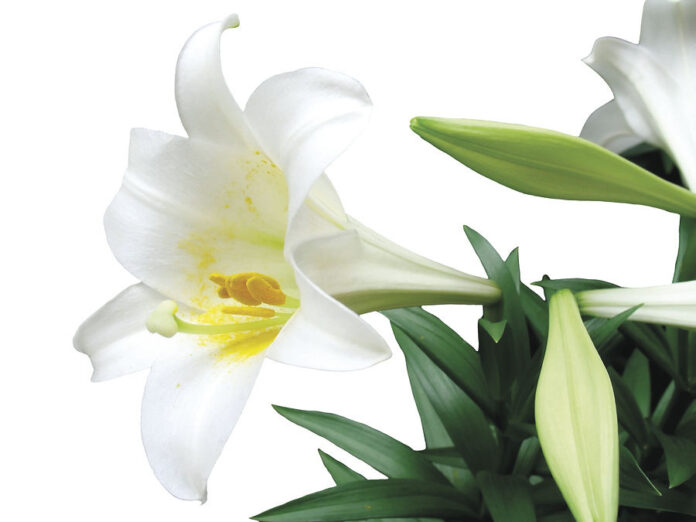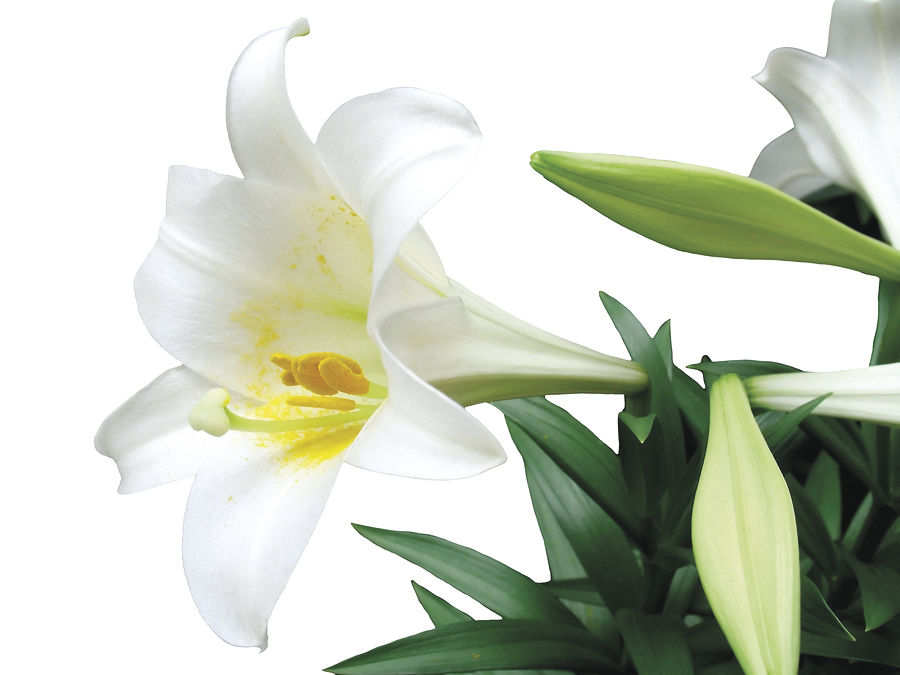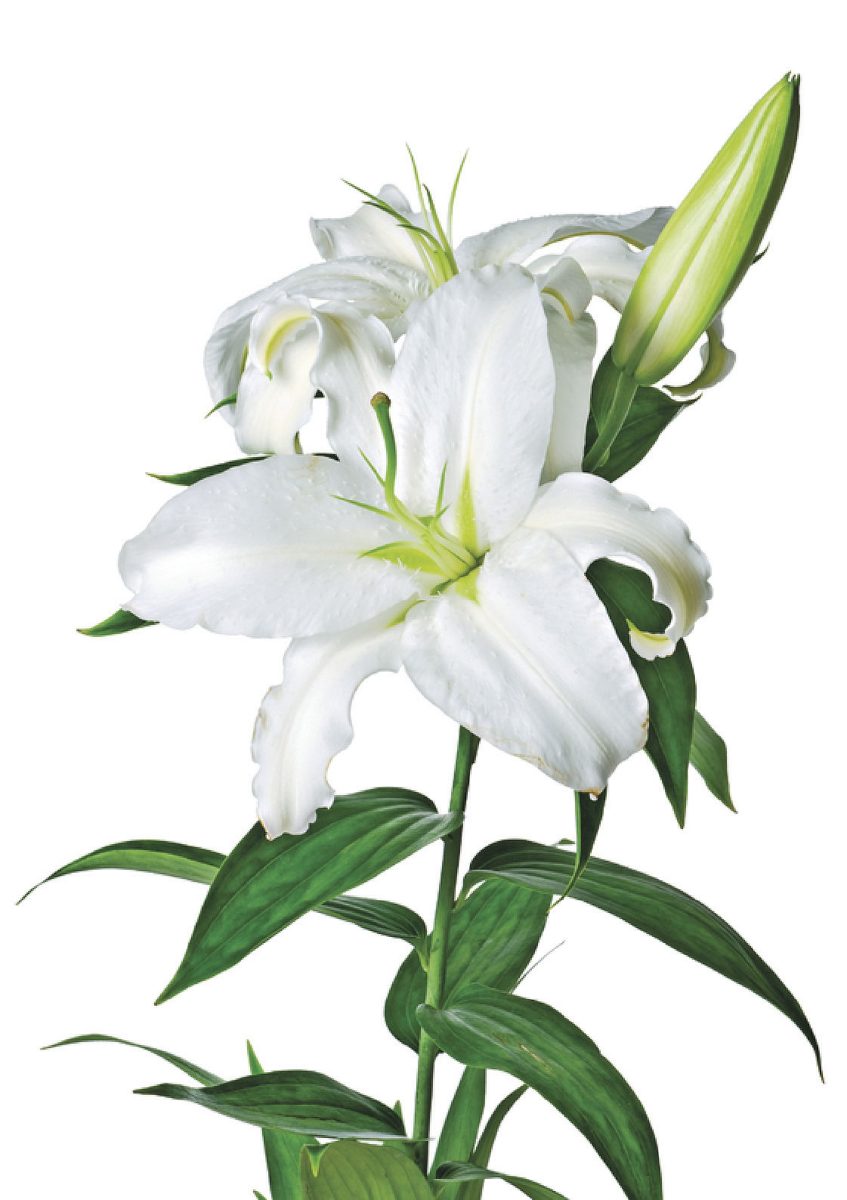BY LORI MURRAY , Texas Superstar Specialist
The beautiful trumpet-shaped white flowers that blanket our altars this special season symbolize purity, innocence, hope, and life – the spiritual essence of Easter. History, mythology, literature, poetry, and the world of art are rife with stories and images that speak of the beauty and majesty of these elegant flowers.
Often called “the white-robed apostles of hope,“ lilies were found growing in the Garden of Gethsemane after Christ’s Agony. Tradition has it that the beautiful white lilies sprang up where drops of Christ’s sweat fell to the ground in His final hours of sorrow and deep distress. Churches continue this tradition at Easter time by banking their altars and surrounding their crosses with masses of Easter Lilies to commemorate the resurrection of Jesus and the hope of
everlasting life.
Since the beginning of time, lilies have played a sIgnificant role in allegorical tales concerning motherhood. Roman mythology links the lily to Juno, the queen of the gods. The story goes that while Juno was nursing her son Hercules, excess milk fell from the sky. Although part of it remained above the earth and created the group of stars known as the Milky Way, the remainder fell to earth and created lilies. Another legend has it that the lily sprang from the repentant tears of Eve as she went forth from the Garden of Eden.
The pure white lily has long been associated with the Virgin Mary. In early paintings, the Angel Gabriel is pictured extending to Mary a branch of pure white lilies and announcing that she is to be the mother of the Christ Child. In other paintings saints are pictured bringing vases of white lilies to Mary and the Infant Jesus. Saint Joseph is depicted holding a lily branch in his hands to indicate that his wife Mary was a virgin. A legend tells that when the Virgin Mary’s tomb was visited three days after her burial, it was empty except for bundles of majestic white lilies. Early writers and artists made the lily the emblem of both the Annunciation and of the resurrection of the Virgin, the pure white petals signifying her spotless body and the golden anthers her soul glowing with heavenly light.
A mark of purity and grace throughout the ages, the regal white lily
is a fitting symbol of the greater meaning of Easter. The flowers
embody purity and joy, hope and life, as they grace millions of homes and churches.
Whether given as a gift or enjoyed in your own home, an Easter Lily serves as a beautiful reminder that Easter is a time for rejoicing and celebration.
We can thank Louis Houghton, a World War I soldier, for the popularity of the Bermuda Lily – now known as the Easter Lily – in our country. In 1919 he brought a suitcase full of hybrid lily bulbs to the southern coast of Oregon and gave them to family and friends to plant.
As it turned out, the climate there was ideal for growing this lily, a native of the Ryukyu Islands of Japan, and by 1945 more than 1,000 West Coast growers were producing bulbs for the commercial market.
Despite a sales window of only about two weeks each year, Easter Lilies are the fourth largest potted plant crop in the United States, ranking among poinsettias, mums, and azaleas as America’s favorite potted plant.
For maximum enjoyment of your Easter Lily, remove the yellow anthers before the pollen starts to shed.
This gives longer flower life and prevents the pollen from staining the white petals.
When a mature flower starts to wither after its prime, cut it off to make the plant more attractive while you enjoy the fresher, newly opened blooms.
By LORI MURRAY
Cameron County Master Gardener,
Texas Superstar Specialist
When you get to the point that you are wondering what to do with a somewhat bedraggled potted Easter Lily, take heart! Believe it or not, EASTER LILIES, or Lilium Longiflorum Var. Eximum, “are especially adapted to this area.“
According to Successful Gardening in the Rio Grande Valley of Texas, they require good rich soil, but NO MANURE, so our typical dense soil would best be enriched with compost. In addition to amelioration of the bed’s soil, some thought should be given to the placement of the bed.
The lilies grow better where the bulbs are protected from our hot summer sun, but do require at least a half day of sunshine to bloom well. (I put mine on the south side of the house in a bed that’s shaded in summer but sunny in winter and early spring.) Some of the bulbs are generally in bloom for Easter, while others bloom later. They should not be disturbed until they become crowded – about every three years – when they should be dug up and thinned out. The large bulbs will have grown down to eight or ten inches. The smaller ones, produced along the stem or from scales from the large bulbs, stay near the top. The bulbs should be replanted as quickly as possible, and at about twice the bulb’s length beneath the surface.
According to the same book, a gifted Easter Lily can be planted any time up to September, so cut the stalk halfway down, and plant the lily in a suitable area to weather the dormant months. They will withstand practically any of our cold weather, but the stalks may lie on their sides after several particularly cold days. They need very little water from the time the foliage dies down in the spring until they begin to grow again in the fall.
When you cut a flower from the blooming plant, leave about half the stalk for food so it will produce blooms the next year.






